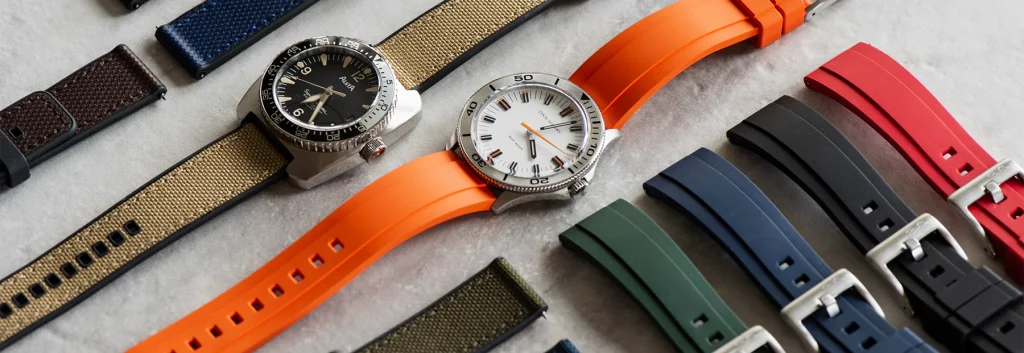Introduction
When it comes to selecting the perfect watch strap, it’s not just about aesthetics; you must also consider the technical details, especially the watch lug width. The lug width plays a crucial role in ensuring that your chosen strap fits correctly and securely, providing both comfort and style. In this article, we’ll explore what lug width is, how to measure it, and why it’s essential for strap compatibility.
1. What is Lug Width?
Lug width refers to the distance between the two lugs (the protruding parts of the watch case that hold the strap in place) measured in millimeters. This measurement determines which size strap or bracelet will fit your watch.
How Lug Width Affects Strap Fit:
- Correct Fit: A strap with the same lug width as your watch will sit flush against the lugs, providing a secure fit.
- Too Narrow: A strap that’s too narrow will have gaps and look out of place.
- Too Wide: A strap that’s too wide won’t fit securely into the lugs and can be uncomfortable or even unsafe to wear.
2. How to Measure Lug Width
To ensure you choose the right strap size, you need to measure your watch’s lug width. Here’s how to do it:

Step-by-Step Guide:
- Get a Caliper: A digital or dial caliper is the most accurate tool for measuring lug width.
- Place the Caliper on the Lugs: Open the caliper and measure the inside distance between the two lugs.
- Check the Measurement: Make sure the caliper is aligned properly, and the measurement is in millimeters. This is your lug width.
Pro Tip: If you don’t have a caliper, you can also use a ruler, but for the most precise measurement, a caliper is recommended.
3. Common Lug Width Sizes
While lug widths can vary, there are a few standard sizes that are most commonly found in watches. The most common lug widths are:
- 18mm: Often found in smaller, vintage-style watches.
- 20mm: A very common size, found in many casual and dress watches.
- 22mm: Common in larger watches, particularly sportier models.
- 24mm and Beyond: These sizes are typically found in dive watches or oversized watches.
It’s essential to know your watch’s lug width so you can select the correct strap size and ensure the perfect fit.
4. Choosing the Right Strap for Your Watch
Once you know your lug width, you can start choosing the perfect strap. Here’s what you should consider:
Material Options
- Leather: A classic and versatile option that pairs well with dress and casual watches. Leather straps come in various finishes, including smooth, textured, and crocodile-embossed.
- NATO Straps: These durable, fabric straps are available in various colors and are great for casual or sporty watches.
- Rubber: Ideal for dive watches or sportier models, rubber straps are comfortable, water-resistant, and easy to maintain.
- Metal Bracelets: These offer a more formal look, and many high-end watches come with metal bracelets. When choosing, ensure the bracelet links can be adjusted for a perfect fit.
Color and Style Considerations
- Match the Watch Face: When selecting a strap, consider matching or complementing the watch face color and style. A classic black or brown leather strap pairs well with most dress watches, while a vibrant NATO strap can add personality to casual wear.
- Occasion: Leather is generally more formal, while rubber or nylon is more suited for sporty or outdoor activities. Consider the occasion to ensure your strap complements your outfit.
5. Strap Compatibility Beyond Lug Width
While lug width is the most critical measurement when choosing a new strap, other factors contribute to compatibility:
Strap Length
Most straps come in standard lengths, but if you have a larger or smaller wrist, make sure the strap is long enough to fit comfortably. Some brands offer straps in multiple lengths, while others offer adjustable options.
Buckle or Clasp Type
Depending on your watch’s design, you may prefer a traditional buckle, a deployant clasp, or a tang buckle. Ensure that the clasp style matches your chosen strap.
Spring Bars
The spring bars are small metal pins that attach the strap to the watch case. Ensure that the spring bars are compatible with the lugs of your watch to ensure a secure fit. If you’re replacing an old strap, make sure the spring bars can fit the new strap.
6. How to Swap Your Watch Strap
Changing your watch strap is a relatively simple process, but it does require care to ensure you don’t damage your watch. Here’s how to swap out your strap:

Tools You’ll Need:
- Spring Bar Tool: This is a specialized tool that allows you to remove and replace spring bars.
- Cloth or Pad: Lay your watch on a soft cloth to protect the watch from scratches.
Steps to Swap the Strap:
- Remove the Old Strap: Use the spring bar tool to compress the spring bars on either side of the watch, and carefully remove the strap.
- Attach the New Strap: Line up the new strap with the lugs and insert the spring bars into place. Press them in carefully until they snap securely.
- Check the Fit: Ensure the strap is firmly attached before wearing the watch.
7. Common Strap Mistakes to Avoid
When replacing or choosing a strap, avoid these common mistakes:
- Incorrect Lug Width: Always double-check your watch’s lug width to avoid choosing a strap that doesn’t fit.
- Overly Tight Straps: A strap that’s too tight can be uncomfortable and can also damage the leather or material. Ensure the strap fits snugly but not too tight.
- Incompatible Materials: Certain materials, such as metal and rubber, may not work well together. For example, pairing a rubber strap with a dress watch may look out of place.
8. Conclusion
Understanding lug width and strap compatibility is key to enhancing the comfort and style of your watch. By knowing your watch’s lug width and selecting the right strap material, color, and length, you can ensure that your watch looks great and fits perfectly. With the right strap, your timepiece becomes not just a functional tool but an expression of your personal style.
By following these tips, you can easily swap straps, refresh your look, and enjoy the full potential of your watch. So, next time you’re looking for a new strap, keep lug width in mind, and enjoy the art of customizing your watch.

